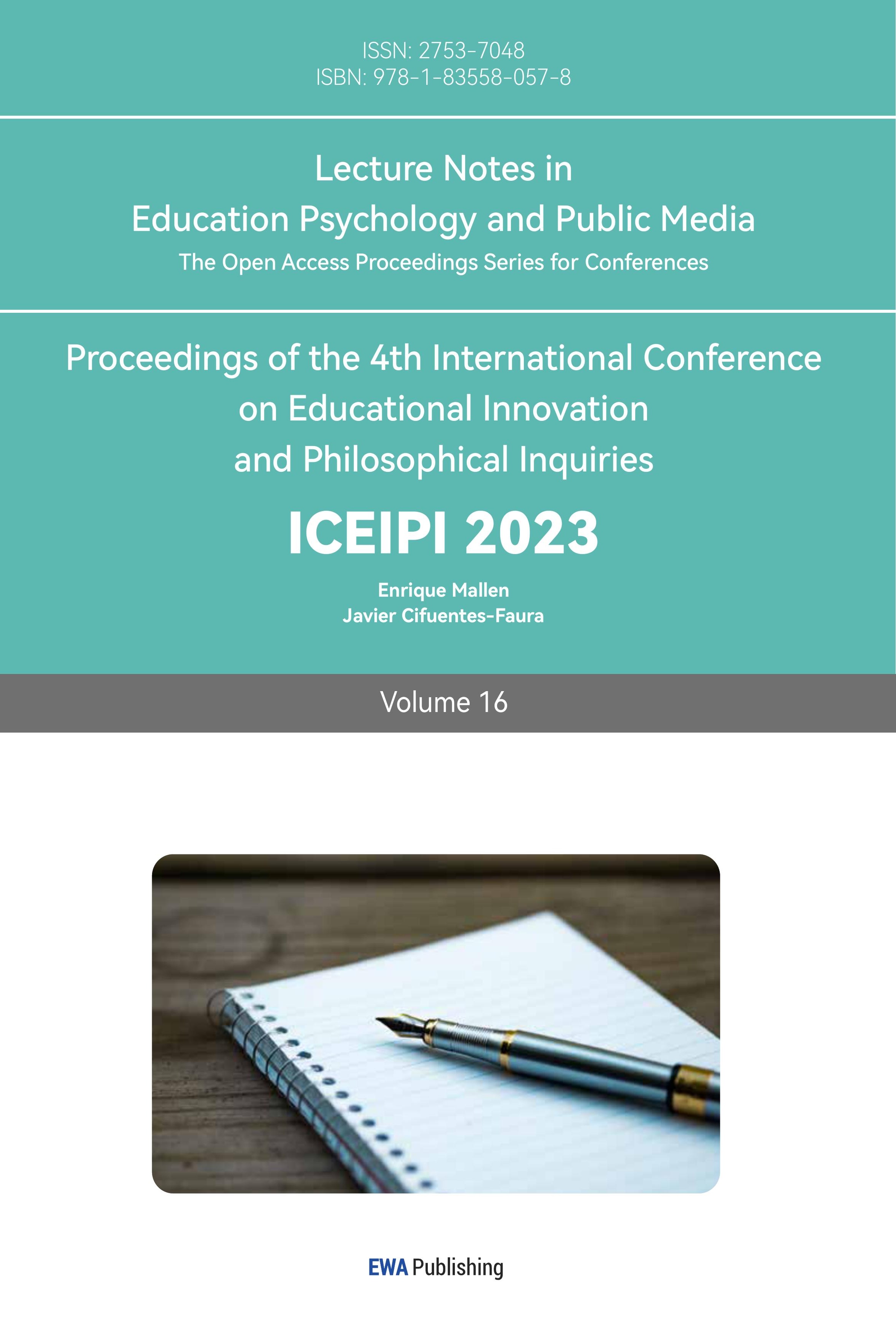References
[1]. Bowlby, J. (1982) Attachment and loss: Retrospect and prospect American Journal of orthopsychiatry, 52 (4), 664.
[2]. Mary, D. Salter ainsworth (1978). The Bowlby Ainsworth attachment theory Behavioral and Brain Sciences (3) Doi:10.1017/s0140525x00075828.
[3]. Bartholomew,K,&Horowitz,L.M.(1991).Attachment styles among young adults:A test of a four category model.Journal of Personality and Socia.
[4]. Jin F (2018). Study on the relationship between attachment style, sexual communication and intimacy satisfaction [d]. Harbin Engineering University.
[5]. Liu Y (2022). Research on the relationship between adult attachment, sacrifice motivation and intimacy satisfaction of college students (Master’s thesis, Tianjin Institute of Physical Education) https://kns.cnki.net/KCMS/detail/detail.aspx?dbname=CMFD202202&filename=1022505862.nh
[6]. Cu M. Adult attachment, conflict resolution behavior and intimacy satisfaction of College Students’ lovers (Master’s thesis, Zhejiang University of science and Technology) https://kns.cnki.net/KCMS/detail/detail.aspx?dbname=CMFD201402&filename=1014228250.nh
[7]. Brennan, K. A., Clark, C. L., and Shaver P. R. (1998). Self report measurement of adult attachment: An integrated overview In: Simpson J A, rholes w s eds. attachment theory and choice relationships, New York; The Guilford press, 46-76.
[8]. Wang X (2019). The impact of adult attachment on intimacy violence (Master’s thesis, Harbin Engineering University) https://kns.cnki.net/KCMS/detail/detail.aspx?dbname=CMFD202101&filename=1020161215.nh
[9]. Wang l (2021). A survey of attachment types and intimacy quality of college students. Educational observation (09), 60-63. doi:10.16070/j.cnki.cn45-1388/g4s.2021.09.018.
[10]. Main, M, Kaplan, N& Cassidy, J (1985). Security in finance, child development, and adult:a move to the level of representation.chronicles of the society for research in child development, so (1/2), 66-104.
[11]. Zhaishuna Sacrifice motivation in college students’ intimate relationship and its impact on relationship quality [d]. Henan University, 2014.
[12]. Bandura A. self-efficiency: toward a unifying theory of behavioral change. Psychological Review, 197784191-215.
Cite this article
Peng,Y. (2023). The Relationship Between Attachment and Intimacy. Lecture Notes in Education Psychology and Public Media,16,207-212.
Data availability
The datasets used and/or analyzed during the current study will be available from the authors upon reasonable request.
Disclaimer/Publisher's Note
The statements, opinions and data contained in all publications are solely those of the individual author(s) and contributor(s) and not of EWA Publishing and/or the editor(s). EWA Publishing and/or the editor(s) disclaim responsibility for any injury to people or property resulting from any ideas, methods, instructions or products referred to in the content.
About volume
Volume title: Proceedings of the 4th International Conference on Educational Innovation and Philosophical Inquiries
© 2024 by the author(s). Licensee EWA Publishing, Oxford, UK. This article is an open access article distributed under the terms and
conditions of the Creative Commons Attribution (CC BY) license. Authors who
publish this series agree to the following terms:
1. Authors retain copyright and grant the series right of first publication with the work simultaneously licensed under a Creative Commons
Attribution License that allows others to share the work with an acknowledgment of the work's authorship and initial publication in this
series.
2. Authors are able to enter into separate, additional contractual arrangements for the non-exclusive distribution of the series's published
version of the work (e.g., post it to an institutional repository or publish it in a book), with an acknowledgment of its initial
publication in this series.
3. Authors are permitted and encouraged to post their work online (e.g., in institutional repositories or on their website) prior to and
during the submission process, as it can lead to productive exchanges, as well as earlier and greater citation of published work (See
Open access policy for details).
References
[1]. Bowlby, J. (1982) Attachment and loss: Retrospect and prospect American Journal of orthopsychiatry, 52 (4), 664.
[2]. Mary, D. Salter ainsworth (1978). The Bowlby Ainsworth attachment theory Behavioral and Brain Sciences (3) Doi:10.1017/s0140525x00075828.
[3]. Bartholomew,K,&Horowitz,L.M.(1991).Attachment styles among young adults:A test of a four category model.Journal of Personality and Socia.
[4]. Jin F (2018). Study on the relationship between attachment style, sexual communication and intimacy satisfaction [d]. Harbin Engineering University.
[5]. Liu Y (2022). Research on the relationship between adult attachment, sacrifice motivation and intimacy satisfaction of college students (Master’s thesis, Tianjin Institute of Physical Education) https://kns.cnki.net/KCMS/detail/detail.aspx?dbname=CMFD202202&filename=1022505862.nh
[6]. Cu M. Adult attachment, conflict resolution behavior and intimacy satisfaction of College Students’ lovers (Master’s thesis, Zhejiang University of science and Technology) https://kns.cnki.net/KCMS/detail/detail.aspx?dbname=CMFD201402&filename=1014228250.nh
[7]. Brennan, K. A., Clark, C. L., and Shaver P. R. (1998). Self report measurement of adult attachment: An integrated overview In: Simpson J A, rholes w s eds. attachment theory and choice relationships, New York; The Guilford press, 46-76.
[8]. Wang X (2019). The impact of adult attachment on intimacy violence (Master’s thesis, Harbin Engineering University) https://kns.cnki.net/KCMS/detail/detail.aspx?dbname=CMFD202101&filename=1020161215.nh
[9]. Wang l (2021). A survey of attachment types and intimacy quality of college students. Educational observation (09), 60-63. doi:10.16070/j.cnki.cn45-1388/g4s.2021.09.018.
[10]. Main, M, Kaplan, N& Cassidy, J (1985). Security in finance, child development, and adult:a move to the level of representation.chronicles of the society for research in child development, so (1/2), 66-104.
[11]. Zhaishuna Sacrifice motivation in college students’ intimate relationship and its impact on relationship quality [d]. Henan University, 2014.
[12]. Bandura A. self-efficiency: toward a unifying theory of behavioral change. Psychological Review, 197784191-215.









